Vintage 1935 Mae West Goin' To Town Photograph Atlanta Paramount Movie Theater
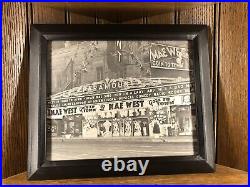

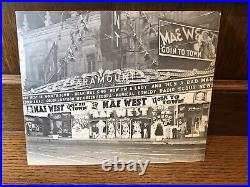


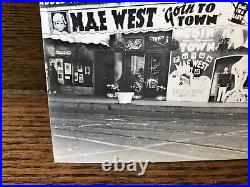
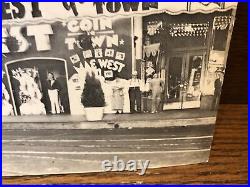
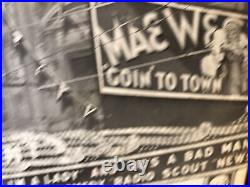
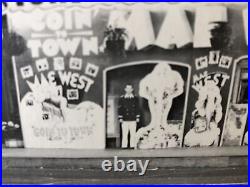
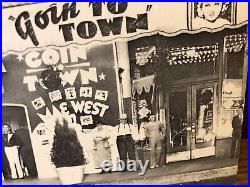
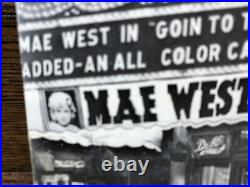


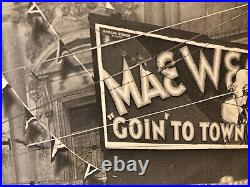



Vintage 1935 Mae West Goin' To Town Photograph Atlanta Paramount Movie Theater. This 1935 original, vintage photograph shows the front of Atlanta's PARAMOUNT THEATRE. That is advertising the Movie Mae West - Goin to Town.
Paramount Theatre 169 Peachtree Street NE, Atlanta, GA 30303 Atlanta Paramount Theatre in 1938. About Mae West & Goin to Town. Goin' To Town is a 1935 musical comedy film directed by Alexander Hall and written by Mae West. The film stars Mae West, Paul Cavanagh, Gilbert Emery, Marjorie Gateson, Tito Coral and Ivan Lebedeff. The film was released on April 25, 1935, by Paramount Pictures.
[1][2] the film stars West as Lady Lou, a wealthy and flamboyant woman who travels to Texas to claim an inheritance and becomes embroiled in a series of comical misunderstandings and romantic entanglements. Mae West was already a well-known actress, singer, and playwright when Goin' To Town was released, and her bold, controversial performances and bawdy, irreverent humor had made her a popular figure in Hollywood's pre-Code era. In Goin' To Town, she brings all of these qualities to the role of Lady Lou, delivering a memorable and entertaining performance that has helped to make the film a classic of its time. The film was a box office success upon its release and received generally positive reviews from critics, who praised its humor and West's performance. In the years since its release, Goin' To Town has continued to be remembered and enjoyed by audiences, and it remains a popular choice for fans of classic Hollywood cinema.
Despite the passage of time, Goin' To Town remains a fresh and entertaining film that is sure to delight audiences of all ages. Whether you're a fan of Mae West or just looking for a fun and lighthearted comedy. Plot [icon] This section needs expansion. You can help by adding to it. (July 2015) Cast Mae West as Cleo Borden Paul Cavanagh as Edward Carrington Gilbert Emery as Winslow Marjorie Gateson as Mrs. Crane Brittony Tito Coral as Taho Ivan Lebedeff as Ivan Valadov Fred Kohler as Buck Gonzales Monroe Owsley as Fletcher Colton Grant Withers as Young Stud Luis Alberni as Sr. Vitola Lucio Villegas as Señor Ricardo Lopez Mona Rico as Dolores Lopez Wade Boteler as Ranch foreman Paul Harvey as Donovan Joe Frye as Laughing Eagle Vladimar Bykoff as Tenor. The Paramount Theatre was a movie palace in downtown Atlanta, Georgia, United States. The building was designed by Philip T. Shutze and was completed in 1920 as the Howard Theatre, a name it kept until 1929. It was located at 169 Peachtree Street, in an area that soon became the location of several other major theaters, earning it the nickname "Broadway of the South". With a seating capacity of 2,700, it was at the time the second largest movie theater in the world, behind only the Capitol Theatre in New York City. In addition to functioning as a movie theater, the building hosted live performances, with several nationally renowned orchestras playing at the venue through the 1940s and Elvis Presley playing at the theater in 1956. By the 1950s, however, movie palaces faced increased competition from smaller movie theaters and the rise in popularity of television, and the Paramount was demolished in 1960. [2] On March 28, 1919, [3] the Adairs agreed to lease the land to C. And George Troup Howard, [2] the latter of whom was a successful cotton merchant. [3] At the end of the 25-year lease, the property, including the theater, would revert to the Adairs. [3] Prior to the theater's construction, several one-story commercial stores were located on the property. [5] The design of this new building, to be called the Howard Theatre, was handled by the Atlanta-based architectural firm of Hentz, Reid & Adler, [6] with Philip T. Shutze serving as the building's architect. [note 1] He drew up the designs in 1919 and construction started shortly thereafter. [2] While an August 1920 issue of The City Builder (published by the Atlanta Chamber of Commerce) stated that the theater would be open by October 1, 1920, [13] it was not open to the public until early December of that year.[11] Theater in operation Upon its opening, the theater was well received by the general public. Contemporary publications in the city called it one of the "show spots of the city"[11] and the "wonder theater of the South", [12] while historian Franklin Garrett later called the building "by far the most palatial movie house ever erected in the city". [4] The construction of the Howard was considered the start of a major boom of movie palaces in the city, [13] with the Metropolitan Theater, which had been under construction at the same time as the Howard, [13] opening shortly afterwards. [10] The Howard had been built along Peachtree Street near Loew's Grand Theatre, an area which soon became known as the "Broadway of the South" in reference to the numerous theaters there.
[6][14] As a performing arts venue, the theater hosted the Atlanta Symphony Orchestra during their inaugural 1923 season, [15] and the 35-piece[11] orchestra was led by conductor Enrico Leide. [16][17][18] In April 1921, the theater hosted actress Clara Kimball Young, who was promoting her new film Straight from Paris, [19] and in August 1923, it hosted a memorial service for recently deceased United States President Warren G.
[21] Over the next several decades, the theater remained a major venue for the city. In 1940, The Salvation Army held a meeting there that saw former General Evangeline Booth as the guest of honor, alongside other guests such as Clark Howell, the editor of The Atlanta Constitution, and Georgia Governor Eurith D. [22] Throughout the decade, the theater hosted numerous nationally renowned orchestras, [23] and between June 22 and 24, 1956, Elvis Presley performed ten shows at the theater. [24] However, by this time, the grand movie palaces in Atlanta, as in other cities across the United States, were facing increased competition from smaller movie theaters in suburban areas and from the rise in popularity of television. [6] As a result, several of Atlanta's landmark movie theaters were demolished in the latter half of the 20th century. [6] The Paramount was one of these, being demolished in 1960 and replaced by a 12-story building.[6] Architecture A black and white photograph of the interior of a theatre auditorium Auditorium of the theater, 1921 The theater building had dimensions of 90 feet (27 m) by 275 feet (84 m). [13] It was located along Peachtree Street, near its intersection with Forsyth Street, [9] and the building stretched the entire length of the city block it sat on, having a backside abutting Ivy Street. [2] It was located next to the Hotel Aragon and was across the street from the Davison-Paxon-Stokes flagship department store. [13][5] Both the Peachtree and Ivy sides of the building had a frontage of about 90 feet (27 m). [2] The building was designed in the Italian Renaissance style, [13] with a facade modeled after the Palazzo Chiericati designed by Andrea Palladio.
[7] This building marked one of the first designs by Shutze to incorporate Italian influences. [7] The building's facade was composed entirely of limestone, [13] and the main entrance consisted of an arched opening measuring 35 feet (11 m) tall and 35 feet (11 m) wide.
[13] A large marquee was on the Peachtree entrance, [6] which also hosted several small shops. [13] The interior of the theater was designed in the Italian Baroque style.[7] The building had a large open lobby with a grand staircase that led to a mezzanine level that had restrooms and smoking rooms. [13] The staircase and columns in the lobby area were constructed of marble. [12] The auditorium area had no columns that could block viewing of the stage, which could hold up to 50 musicians. [13] The stage was designed to host both live performances and motion pictures. [13] The theater had a seating capacity of 2,700, [12] which made it the largest theater in Atlanta and the second largest movie theater in the world, behind only the Capitol Theatre in New York City.
Black & white, real, huge. Bartender, server, waiter, waitress, collector, pub, bar, tavern, liqueur store, employee, wall art, vintage photo picture old black white photograph family snapshot girl, lady, ladies, women, decor, art, sign, advertising, ad, promo, promotion, tour concert, snapshot, black & white lithograph collectible vintage & antique photos, black & white ambrotype collectible vintage & antique photos, vintage old spice, collectible historic and vintage risque photo, photography poster photo, photography camera, art picture black white vintage, printing and mailing: book catalog phamplet insert sales brochure booklet catalog flyers, leaflets, brochures and booklets, print picture photo framing framed frame art work drawing design painting artist company factory history historic advertisement's messageold antq vtg culture retro vintage antique art deco groundbreaking 19th-century, orig, original, wall, retro, mid centry, fair grounds, Indianapolis, Indy, school 1900,1901,1902, 1903, 1904, 1905, 1906, 1907, 1908, 1909, 1910, 1911, 1912, 1913,1914, 1915, 1916, 1917, 1918, 1919,1920.1921,1922, 1923, 1924, 1925, 1926, 1927, 1928, 1929, 1930, 1931, 1932, 1934, 1935, 1936, 1937, 1938, 1939, 1940, 1941, 1942, 1943, 1944, 1945, 1946, 1947, 1948 1949, 1950, 1951, 1952, 1953, 1954, 1955, 1956, 1957, 1958, 1959,1960.